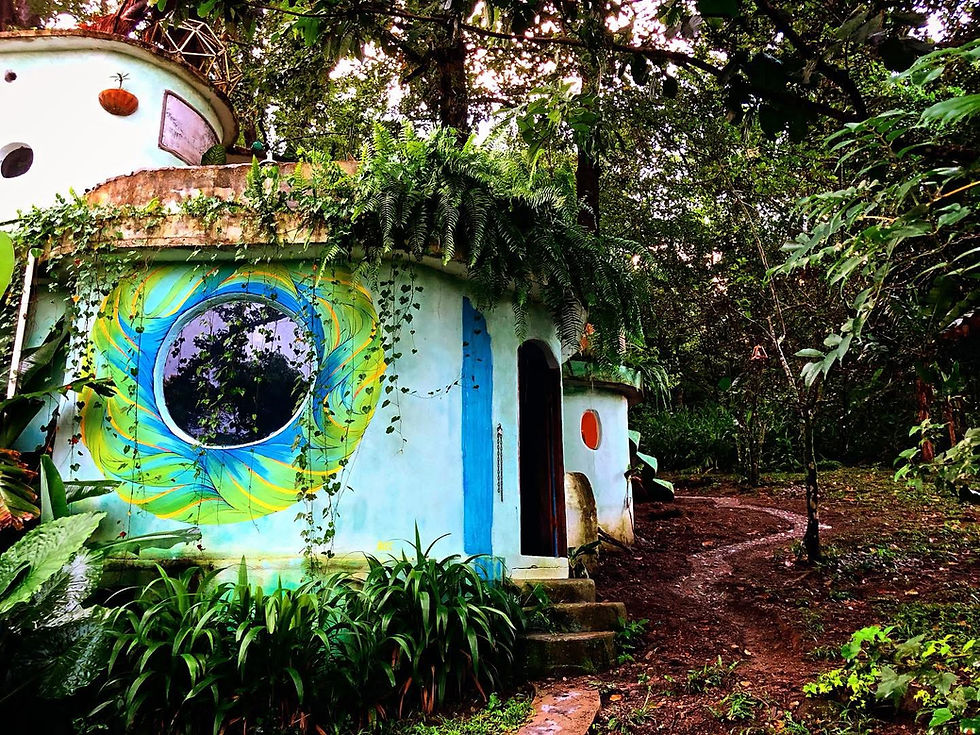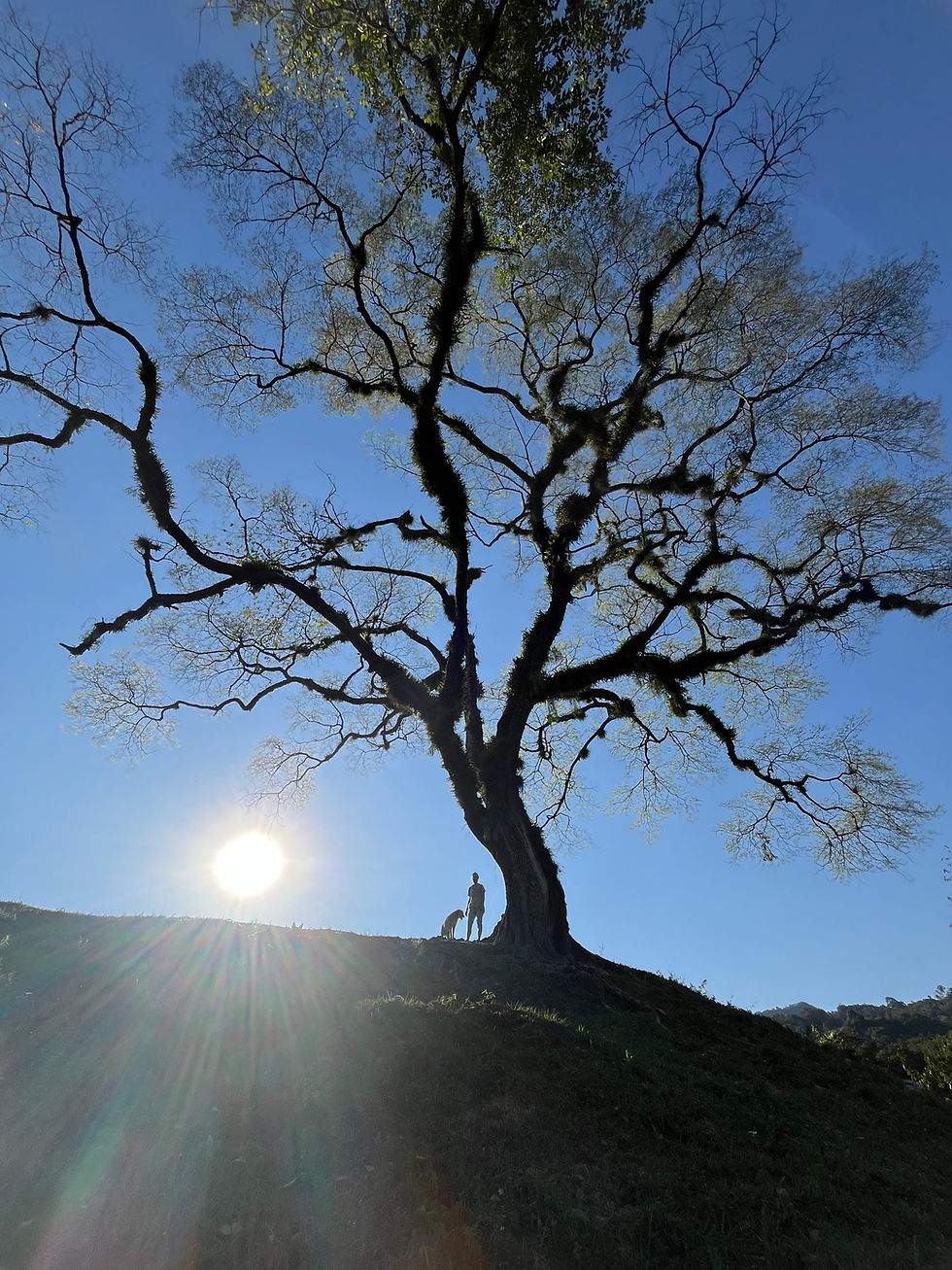Xilitla Magia: A Living Kaleidoscope of Abundance and Imagination
- Jess Mayes

- Aug 21
- 5 min read
Updated: Nov 21
In the mist-wrapped mountains of the Sierra Gorda, the village of Xilitla rises like a dream made of stone, forest, and water. Clouds drift low through valleys, weaving ribbons of silver through coffee groves and orchards. The land breathes with the pulse of springs and rivers, its heartbeat echoing in caves that descend into the earth and in waterfalls that tumble toward the Huasteca plains. To stand here is to be reminded that the world still contains mysteries, and that imagination is not separate from reality but grows directly out of it.

Xilitla Magia is our collective response to this truth. It is a feeling, a project, a vision, and a gathering place that honors the interdependence of nature, culture, and creativity.
While surrealism left its mark in the nearby gardens of Edward James' Las Pozas, the true surreal lies in the living fabric of this land itself. Parrots calling across the canopy at dawn, orchids opening to the mist, butterflies rising like sparks from the undergrowth. The improbable is not imagined here. It is real, and it is bursting with life.

Abundance...
The ecological richness of Xilitla is staggering. More than three hundred species of birds have been recorded in the Sierra Gorda Biosphere Reserve. Brilliant tanagers, shy trogons, and various parrots bring flashes of color to the forest. Hummingbirds hover among bromeliads, and raptors carve circles into the sky above limestone cliffs. At ground level, amphibians and reptiles thrive in the wet forests, while butterflies, hundreds of species strong, fill the air with motion and color, particularly after the summer rains when the forest floor seems to take flight.
Water shapes every story here. The Sótano de las Golondrinas, a cavern so deep that birds spiral for minutes before reaching the sky, is a cathedral of stone and air. The Sótano de las Huahuas, equally majestic, resonates with the calls of swifts and parrots. The Mantetzulel caverns, filled with stalactites and underground chambers, remind us of the hidden rivers that carve this land. Closer to the surface, crystalline pools at Tambaque and Huichihuayán offer moments of reflection where mountain streams gather in turquoise basins.









Just as diverse are the cultural and agricultural traditions. For generations, the Nahua, Teenek (Huastec), Pame, and Otomí peoples have lived within the rhythms of this land. Central to their survival and wisdom is the milpa system, where corn, beans, and squash grow together in mutual support. Corn provides a living scaffold for beans to climb, beans enrich the soil with nitrogen, and squash shades the ground to preserve moisture.

This ancient system is not only practical but profoundly philosophical. It embodies reciprocity, balance, and respect for diversity.
To honor these traditions and to learn from them is essential. Xilitla Magia seeks not to impose but to listen, to amplify local knowledge and connect it with global conversations about regeneration, resilience, and the future of human communities in balance with nature.
Casa de la Montaña: A Portal into the Surreal
The heartbeat of Xilitla Magia will be the Casa de la Montaña. Perched in the folds of the forest, it is envisioned as a space of refuge and of convergence, where the boundaries between disciplines dissolve.

The Casa will welcome writers, artists, musicians, scientists, explorers, students, and seekers. A poet may write in the shadow of the cloud forest, capturing the calls of parrots in verse. A biologist may conduct field studies on pollinators, tracing the movements of melipona bees among native flowers. A painter may find inspiration in the luminous wings of butterflies rising from a canyon at dusk. A team of geologists or speleologists may descend into caves to map underground rivers, while their findings inspire musicians composing soundscapes that echo the depths.





The Casa will not only host individuals, artists, writers, musicians, and explorers but also academic research groups, field schools, and university partnerships. Students from all over the world will be invited to immerse themselves in ecological research, cultural exchange, and applied regenerative practices. Faculty and graduate researchers will collaborate with local communities to study biodiversity, traditional agriculture, hydrology, and the intersections of culture and conservation. Workshops will combine rigorous science with creative expression, ensuring that knowledge circulates in many forms.




Among the offerings at Casa de la Montaña:
Ecological workshops on regenerative farming, watershed health, and cloud forest ecology.
Creative residencies that give artists and writers the space to create in dialogue with the land.
Academic programs partnering with universities for field research, study abroad, and cross-disciplinary collaboration.
Cultural exchanges rooted in Indigenous practices, where stories, music, and food are shared across generations.
Explorations for cavers, birdwatchers, and naturalists who wish to experience the Sierra Gorda’s subterranean and aerial wonders.
Sobremesa conversations, where meals extend into reflection, storytelling, and collective imagination.
The Casa de la Montaña will be more than a building. It will be a living classroom, a studio without walls, and a sanctuary where people come not to escape the world but to engage it more deeply.
An Invitation to Participate
The story of Xilitla Magia is not one of tourism but of participation and regeneration. It is about walking slowly through cloud forest trails, listening to the voices of parrots and cicadas, learning the ancient wisdom of the milpa, and watching butterflies rise like a storm of color into the afternoon sky. It is about sharing meals where local knowledge meets global curiosity, and where art and science speak to each other in new languages that converge to help bring awareness to the ecological richness of this land, to understand why it must be preserved and regenerated.


Edward James’s surreal gardens remain an emblem of wonder in Xilitla, yet the deeper surreal is in the living systems themselves. Magic here is not constructed of concrete and sculpture. It is found in the sudden silence before rain, in the mirrored stillness of a turquoise pool, in the laughter of students and artists who find themselves transformed by this place.

Terra Advocati envisions Xilitla Magia as a space where ecology, culture, and creativity are woven into one fabric. It is a call to writers, artists, scientists, students, and travelers to join in co-creating a new form of stewardship, one that honors both ancestral traditions and contemporary innovation.
The Sierra Gorda is one of Mexico’s last great living tapestries of biodiversity and cultural heritage. To walk into it with open eyes is to discover not only beauty but also responsibility. Xilitla Magia is an invitation to share in that discovery, to step into a landscape where imagination and ecology are inseparable, and where Casa de la Montaña opens as a doorway into new ways of seeing, dreaming, and moving through the world.
More details coming soon!






Comments